Menopause
Menopause is the natural transition that occurs when a woman stops menstruating, which usually happens between the ages of 40 and 58. The term “transition” refers to a change from one state to another, which is a very apt descriptor for what happens during menopause. Hormonally speaking, menopause marks a shift to an entirely new hormonal milieu, which not surprisingly, can be quite challenging.
Hormonal Changes During Menopause
The hormonal changes that accompany menopause are dramatic. From perimenopause (the stage leading up to menopause) to post-menopause (the stage following menopause), levels of estrogen and progesterone drop to a fraction of their previous levels. This sharp decline is not linear, instead showing fluctuations that can create a whirlwind of physical and psychological symptoms. Levels of testosterone also decrease during this transition.
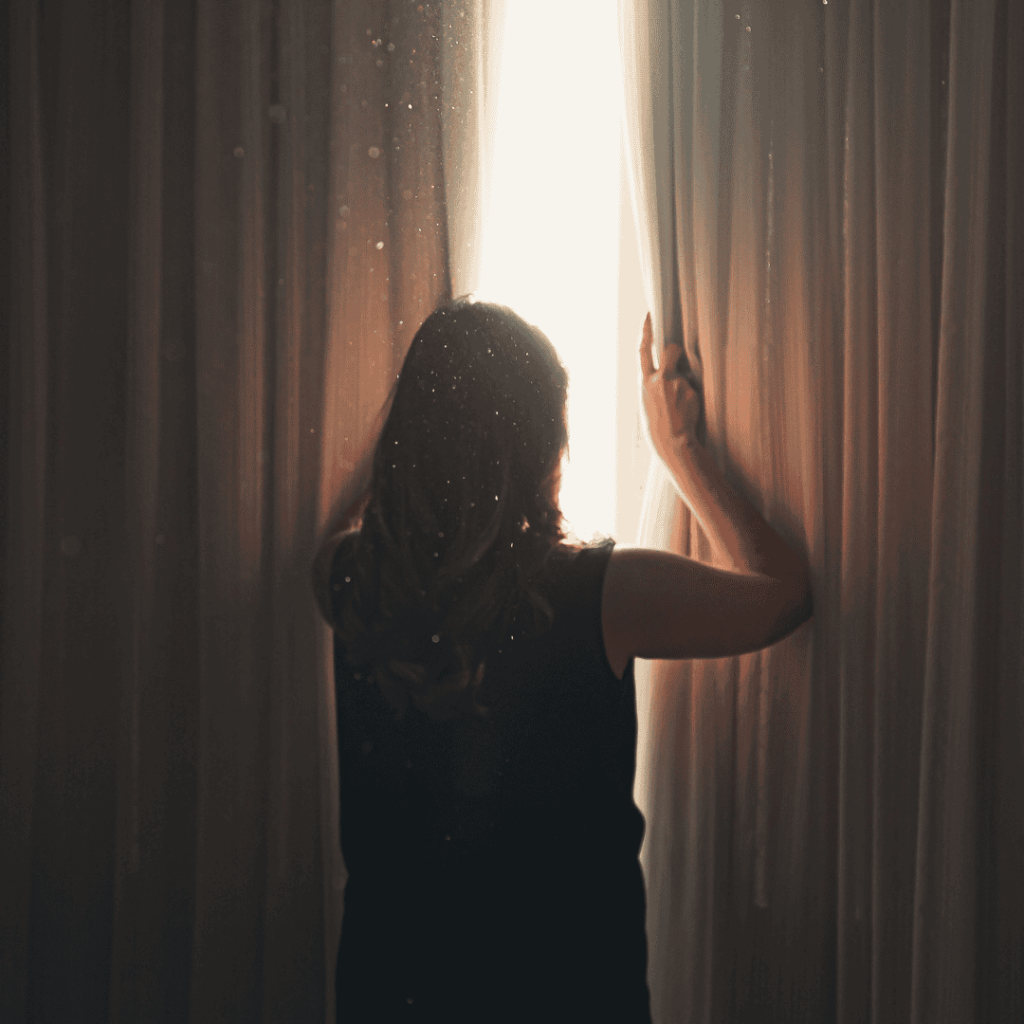

the effects of menopause
The effects of menopause on the brain and body are similarly dramatic. Although these vary widely between individuals, there are many common symptoms, including hot flashes, loss of libido, vaginal dryness, sleep issues, weight gain, dry skin, hair thinning, digestive changes, sexual dysfunction, urinary symptoms (including incontinence) and mood disturbances. Some menopausal symptoms are local, occurring mainly in the pelvic region, while others (such as hot flashes) are felt throughout the body. Similarly, some symptoms are transient while others cause persistent and long-term physical changes.
The experience of menopausal symptoms is extremely common. Overall, it is estimated that 75-80% of women suffer from symptoms related to menopause, of which 20-30% are considered severe. Approximately 75% of women worldwide experience hot flashes, while 40-60% suffer from sleep issues. As many as 83% of women report experiencing vaginal dryness, often with associated pain during intercourse. Research has found that 9 in 10 women weren’t educated about menopause, and since talking about these symptoms has long been viewed as “taboo”, women often suffer menopause symptoms in silence, leaving them unable to access tools that might help to alleviate them.
Improving access to supportive tools during menopause is a critical public health issue. This includes natural and alternative therapies, as well as novel tools such as light therapy. Light – including red, near infrared, and blue light – may help to alleviate several of the challenging symptoms of menopause, including sleep and mood issues, vaginal dryness and atrophy, hair loss, overactive bladder, sexual dysfunction, cognitive and digestive changes, and skin problems. Read on to learn how light therapy can be used to support women’s health during this important transitional period.
light therapy
Before we can explore how light therapy can be used to support women’s health during menopause, we first need to answer the question: what is light therapy?
The answer is really quite simple. Light therapy (also known as photobiomodulation) is the application of light with specific wavelengths to the body for the purposes of influencing biology. In theory, light therapy can use any wavelength of light, but the most commonly used are red, near infrared, and blue. The use of red and near infrared light is commonly referred to as “red light therapy”. All three wavelengths of light may be useful in supporting women during menopause, although red and near infrared light have the greatest utility.

Research has shown that light therapy has many effects on a cellular level. Briefly, with red and/or near infrared light, the most notable observed effects include an increased production of cellular energy, reduced inflammation, decreased oxidative stress, decreased pain, increased blood flow, enhanced collagen and supportive tissue production, and improved microbiome health (gut and vagina). Blue light is mainly used to destroy pathogenic microorganisms like yeast and bacteria.

Light Therapy & Menopause
Given that there is such a wide range of menopausal symptoms (note that for simplicity, symptoms related to peri-, meno- and post-menopause are being considered here as “menopausal” symptoms), it is likely that the various physiological effects of light therapy will be more or less relevant for certain ones.
For example, some of the changes seen during menopause – such as vaginal atrophy, dryness, and urinary incontinence – are due in part to a decrease in blood flow and loss of connective tissue in the pelvis. While specific research into using light therapy to treat these symptoms is still sparce, researchers have proposed that based on existing scientific evidence, red light therapy may alleviate these symptoms by stimulating the production of collagen and elastin, supporting bladder function, and enhancing blood flow.
Many symptoms of menopause are also experienced in other states, and we can look to those conditions for clues regarding how to use light therapy to alleviate the same symptoms during menopause. This includes anxiety and depression, hair loss, sleep disturbances, acne, digestive issues, and infections. While research specific to these symptoms in menopausal women is lacking, there is clear evidence that light therapy (with red, near infrared, and/or blue light) can be helpful in other conditions, and we can extrapolate from there to the menopausal state.
Based on the known physiological effects of light therapy, and the evidence of benefits in a range of clinical conditions, we propose that the use of red, near infrared, and/or blue light may help to alleviate several of the most common symptoms experienced by women during this life transition, including:
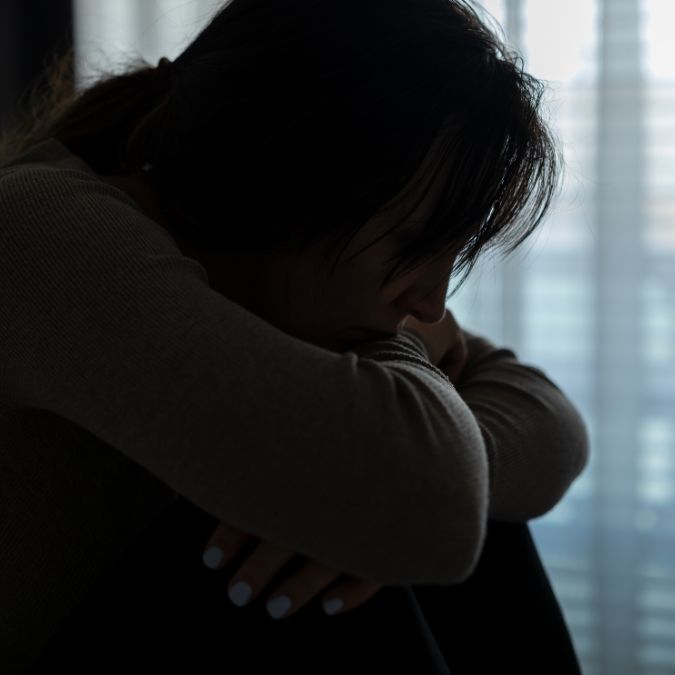
- Mood: Mood changes are a common experience during menopause, with many women reporting increases in anxiety and depression. Light therapy (with red and near infrared light) has been shown to reduce depressive symptoms in both humans and animals, likely due to improvements in mitochondrial function, increased brain blood flow, and decreased neuroinflammation. A 2009 clinical trial found a reduction in symptoms of depression and anxiety in as little as a single session. The effects of light therapy on mental health are so compelling that a recent systematic review concluded that it is “strongly recommended” as a treatment for moderate depressive disorder and is “recommended” for the treatment of anxiety disorder. Studies of red light therapy and depression often apply light therapy directly to the skull, while some use an intranasal approach.
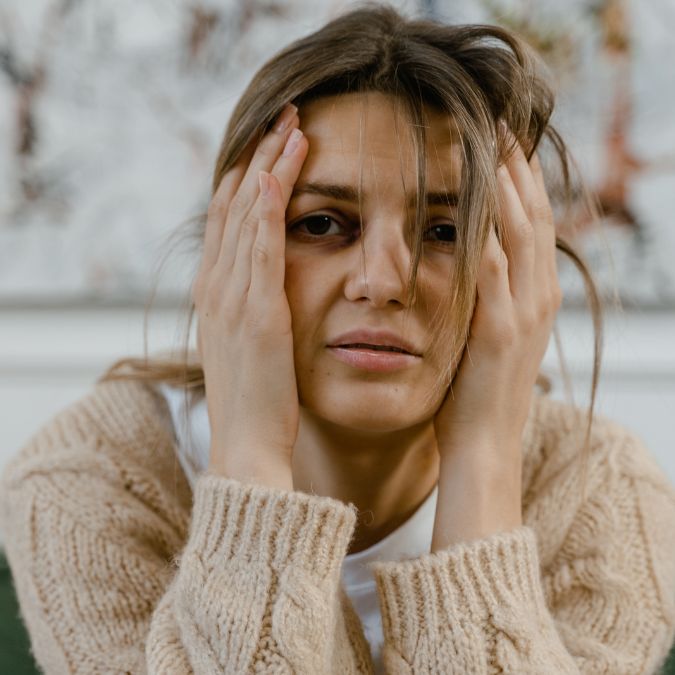
-
Cognition: Cognitive changes, such as memory loss, are also commonly experienced by women during menopause. Researchers have shown in a series of controlled clinical studies that near infrared light therapy improves cognition in young and middle-aged healthy adults when applied to the prefrontal cortex of the brain. Cognitive improvements were accompanied by changes in brain function, including increased brain blood flow. In 2019, a meta-analysis of all the research looking at the effects of light therapy (including near infrared light, or near infrared and red light in combination) found that the overall effect on cognition was positive, leading the authors to conclude that light therapy is a “cognitive-enhancing intervention in healthy individuals”.
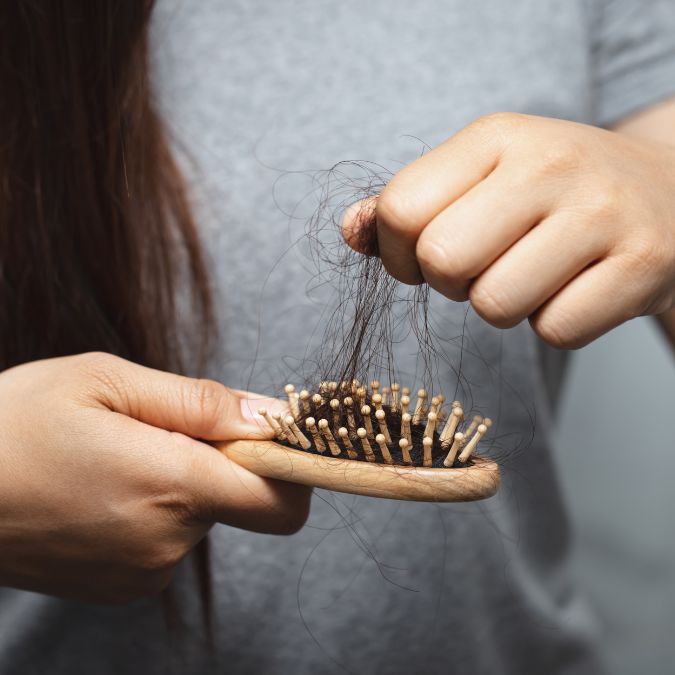
- Hair Loss: Menopausal women frequently report hair loss and thinning. The ability of light therapy to induce hair growth was observed in studies conducted more than 50 years ago. Early clinical trials used primarily red light, and the effectiveness of these studies led to the development of several red light therapy devices for hair loss. Subsequent studies have shown that near infrared light also stimulates hair growth, with red and near infrared light improving hair growth in androgenetic alopecia, which is the most common type of hair loss that affects both men and women. Light impacts hair growth through effects on mitochondria, which lead to increases in the length of time the hair follicle spends in the growth phase.
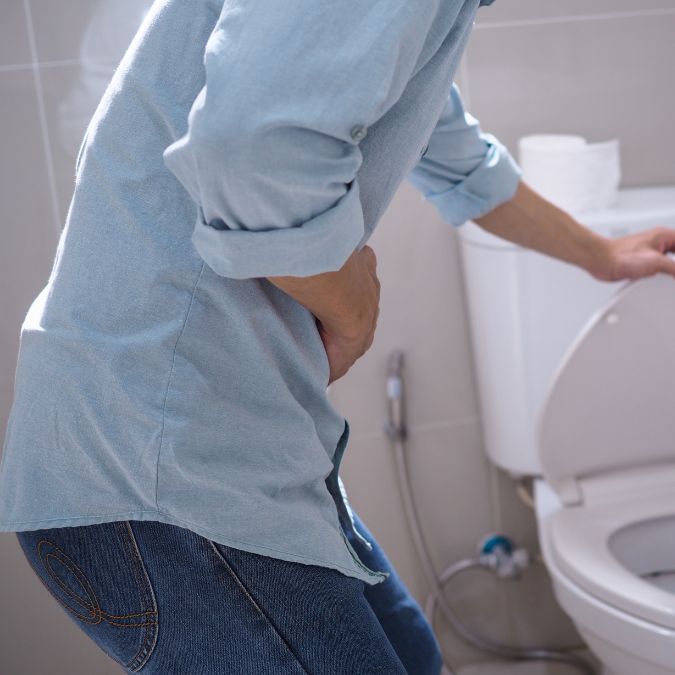
- Overactive Bladder: Overactive bladder, involving a frequent urge to urinate, is a urinary symptom experienced during menopause. Overactive bladder often results in urinary incontinence. Although research related to light therapy and overactive bladder is limited, one study found that application of red light to the abdomen three times per day for 12 weeks resulted in a reduction of urinary incontinence as compared to a control group, suggesting a potential benefit in this condition.
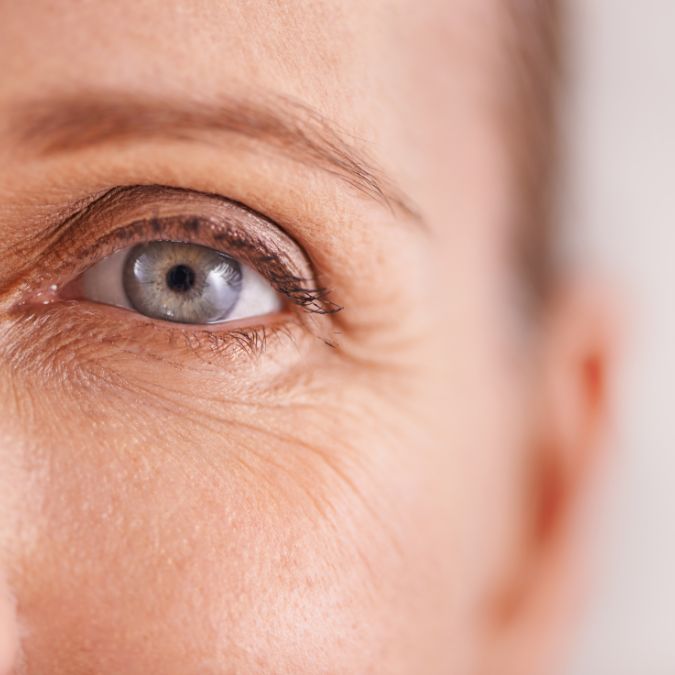
- Skin Changes: During menopause, many women report skin changes, including acne, dryness, altered pigmentation and wrinkles. Light therapy has been widely used in spas and dermatology clinics for its effects on skin health, in addition to at-home use. Red and near infrared light is helpful in the treatment of wrinkles, psoriasis, acne, hyperpigmentation, and rosacea, while blue light is helpful in the treatment of acne. Studies show results such as smoother skin; wrinkle reduction and improved skin elasticity; and normalization of skin pigmentation. The effect of red light therapy on wrinkles can be quite dramatic, with one study showing a 30% decrease in eye wrinkle volume.
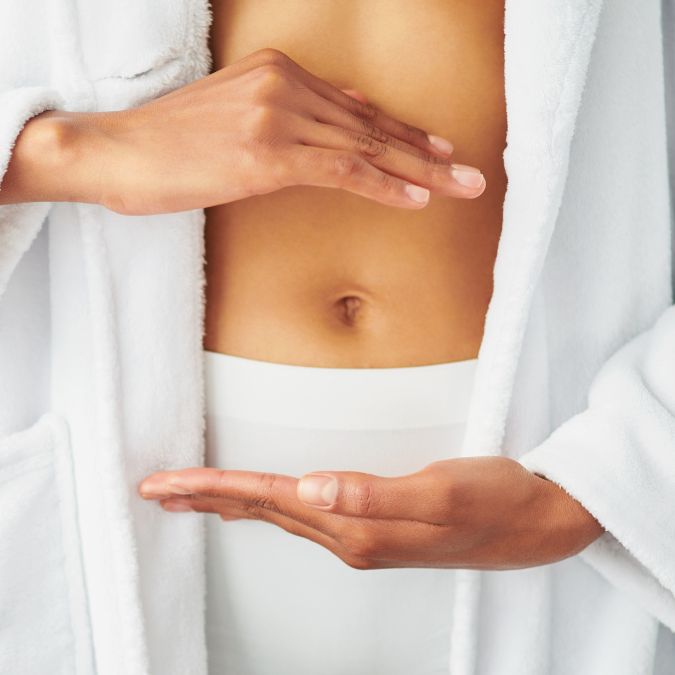
- Gut: Gut dysbiosis, involving changes in the gut microbiome, are common around the time of menopause. Estrogen is known to affect the gut microbiome and similarly, some of the microbes in the gut microbiome (called the estrobalome) are able to influence levels of estrogen in the body. Keeping the microbiome healthy during menopause is essential, and light therapy (with red and near infrared light) may provide some support. Animal research has shown that when red or near infrared light was applied to the abdomen of mice, the composition of the microbiome shifted to include more of a bacterial strain that is associated with better health. In humans, red and near infrared light applied to the abdomen of Parkinson’s disease patients modulated the composition of the gut microbiome, with a shift towards more “healthy” bacteria, and in a case report of a patient with breast cancer, application of near infrared light to the abdomen was associated with increased diversity of gut microbes, which is considered to be a healthy change

- Vaginal Dysbiosis: Similar to the gut, the vagina has a microbiome, and menopause can cause dysbiosis in this region as well. Hormone-induced dysbiosis can increase the vaginal pH and change the composition of the microbes, which is associated with bladder dysfunction and bladder pain syndrome. Light therapy, particularly with red and near infrared light, is proposed as being a positive modulator of the vaginal microbiome. There are several proposed mechanisms, including modulation of nitric oxide. Nitric oxide is important for the lactobacillus species that dominate in the vagina that are known to decrease during menopause.
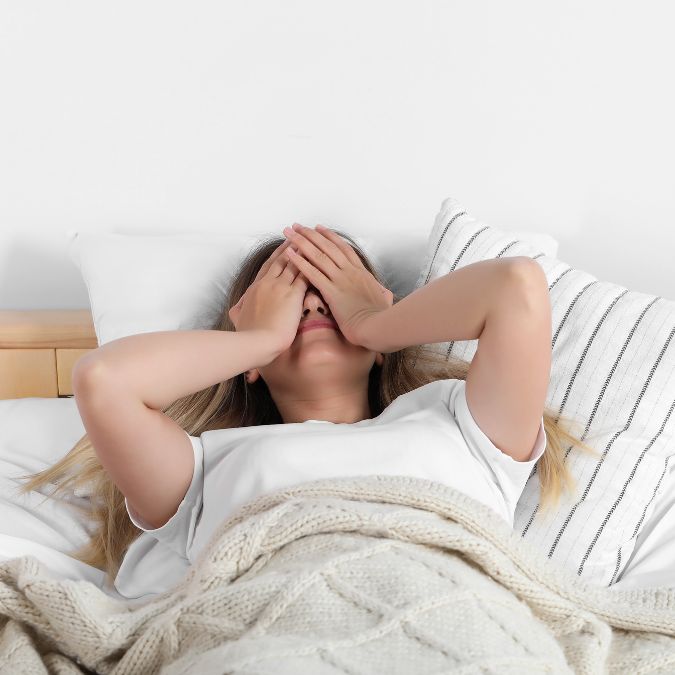
- Sleep: As already mentioned, sleep disturbances are experienced by 40-60% of menopausal women. Light is a primary regulator of the body’s circadian rhythm, so it is not surprising that light therapy has effects on sleep. Application of red and near infrared light during wakefulness improves sleep quality in people with cognitive decline, Guillain-Barré Syndrome, fibromyalgia and stroke. When red light therapy is applied during sleep, there is an increased clearance of waste products from the brain and improved flow of cerebrospinal fluid, which are required for optimal brain health. Blue light triggers wakefulness, suppressing melatonin, so direct exposure of the eyes to blue light should be limited to daytime hours.
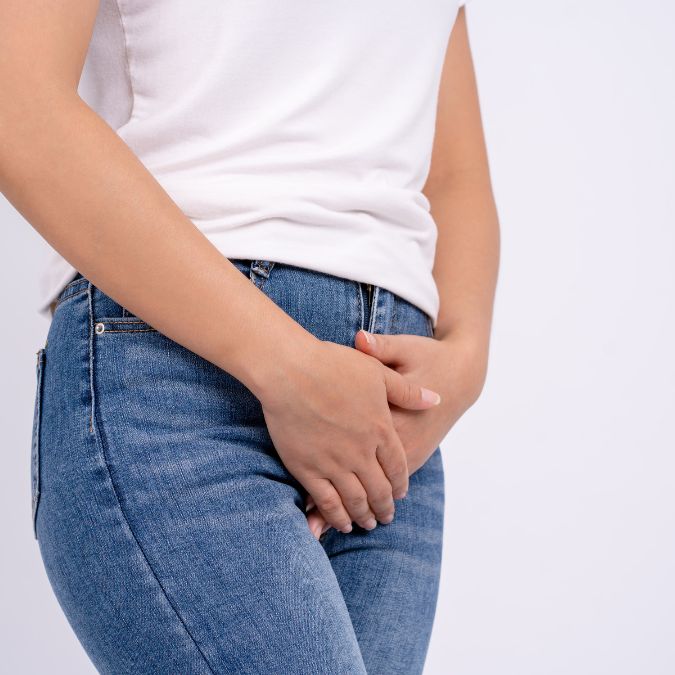
- Vaginal Infections: Vaginal infections with yeast and bacteria are more common during menopause due to the changes in estrogen, vaginal pH, and vaginal dryness that occur. In addition to their positive effects on the microbes in the gut and vagina, red and near infrared light have also been shown to have effects on pathogenic (harmful) microorganisms in the female pelvis. Red light has been shown to be helpful in treating vaginal candida, as has blue light. Specifically, blue light at 415nm (the same wavelength as in the Fringe Pelvic Wand) had the most potent anti-candida effects. Blue light has also been shown to be helpful in the treatment of vulvovaginitis.
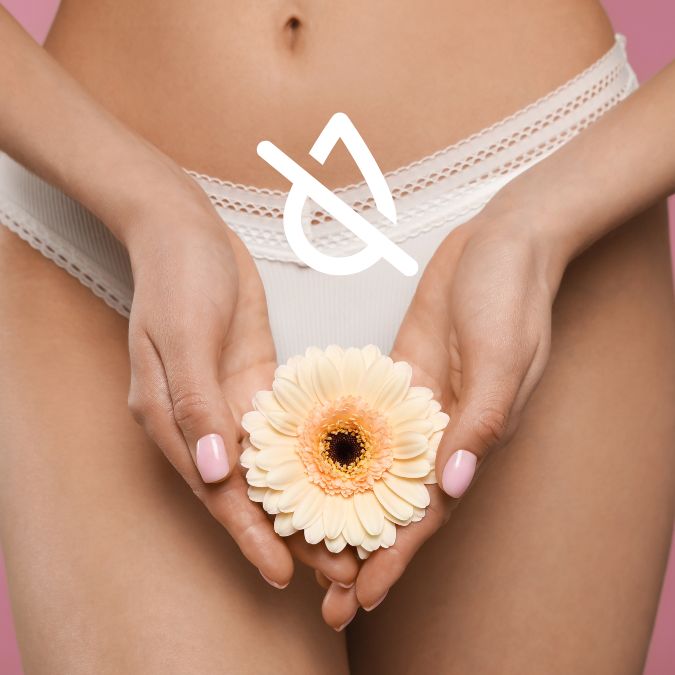
- Vaginal Atrophy: Vaginal Atrophy, Dryness & Sexual Dysfunction: The loss of estrogen during menopause causes many changes to the integrity of tissues in the vagina. This results in tissue atrophy and dryness, which can cause great discomfort, especially during sex. The main structural connective tissues are collagen and elastin, which provide strength and flexibility to the vagina. These changes occur for a variety of reasons, including a decrease in blood flow which results from the loss of estrogen. Application of red and near infrared light is known to increase blood flow by increasing levels of nitric oxide. It has also been shown to increase the synthesis of collagen and other supportive connective tissue including elastin. This suggests that red and near infrared light may help with tissue support and rejuvenation during menopause.
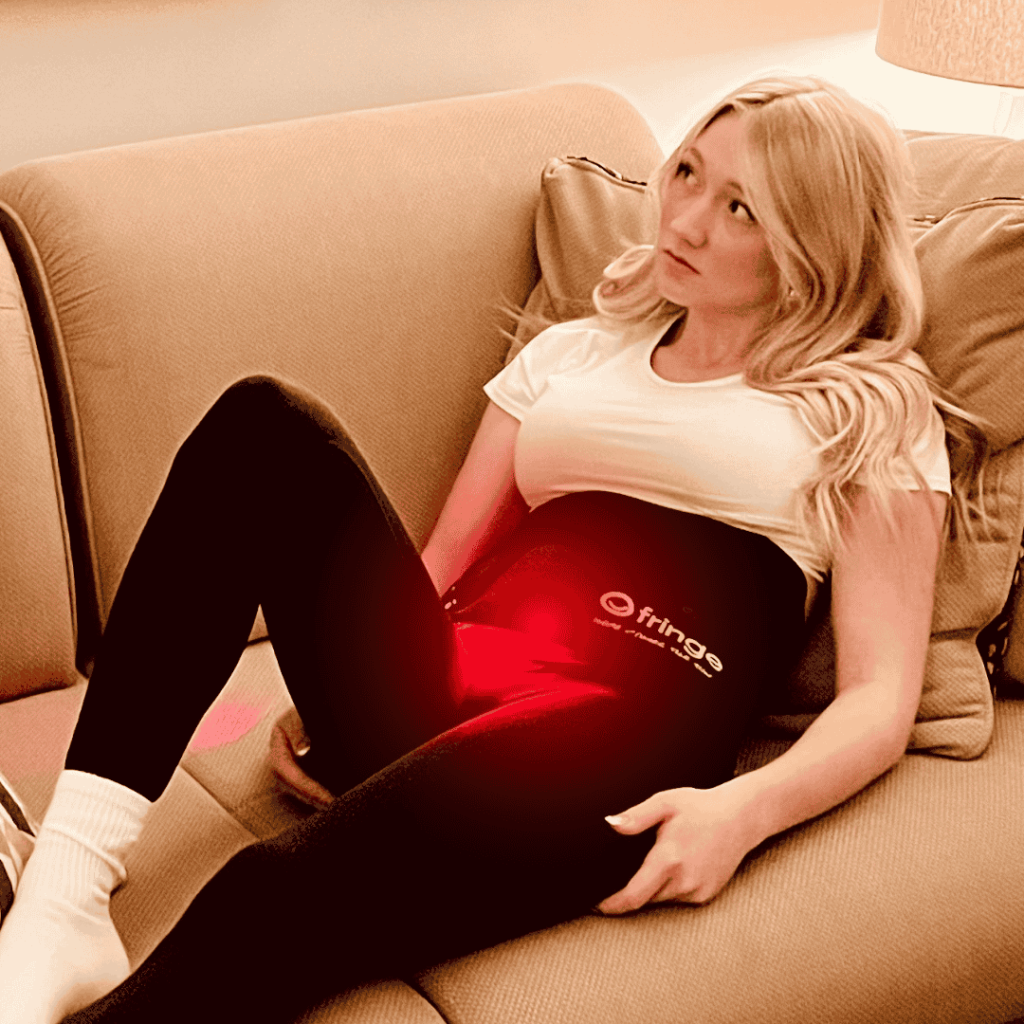
Light Therapy Products for Menopause
While early research on light therapy used primarily lasers, more recent research has found that LED’s can also be used, which also have the advantage of applying light to a larger area of the body as well as an improved safety profile. The use of LED in red/near infrared/blue light therapy devices has also greatly reduced the cost of treatment, making it something that can be done in the comfort of one’s own home. A wide range of products are available, each of which is uniquely suited to address specific needs. The four most useful light therapy products to address the symptoms of menopause are:
red light therapy panel
Panels usually deliver red and near infrared light, ideally with the option to use separately or in combination. Panels can be used to treat most body parts, including the face, chest and back. They’re great for supporting sleep and mood, when light should be entering through the eyes. They can also support digestion when directed towards the skin of the abdomen, as well as the skin on the face. The Fringe Red Light Therapy Panel delivers both wavelengths of light at the same “sweet spot” intensity as the sun.
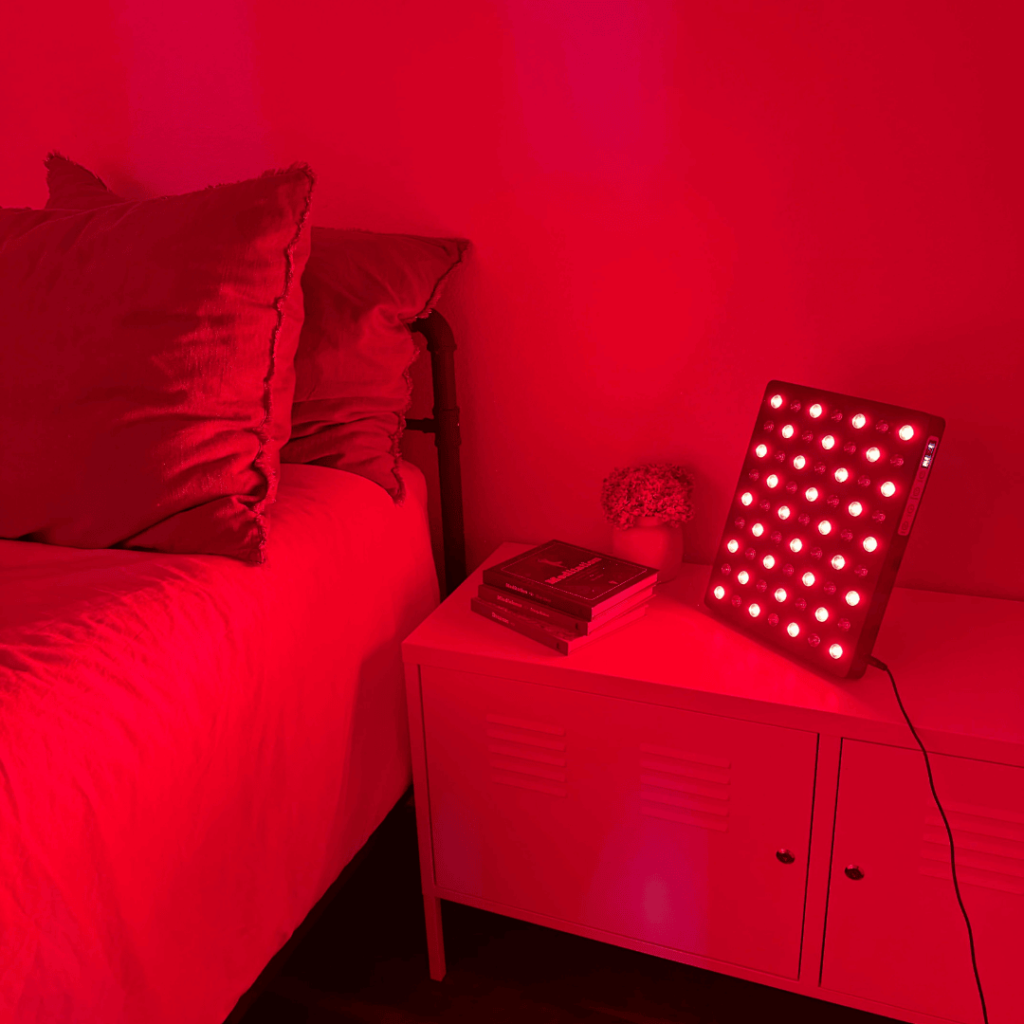
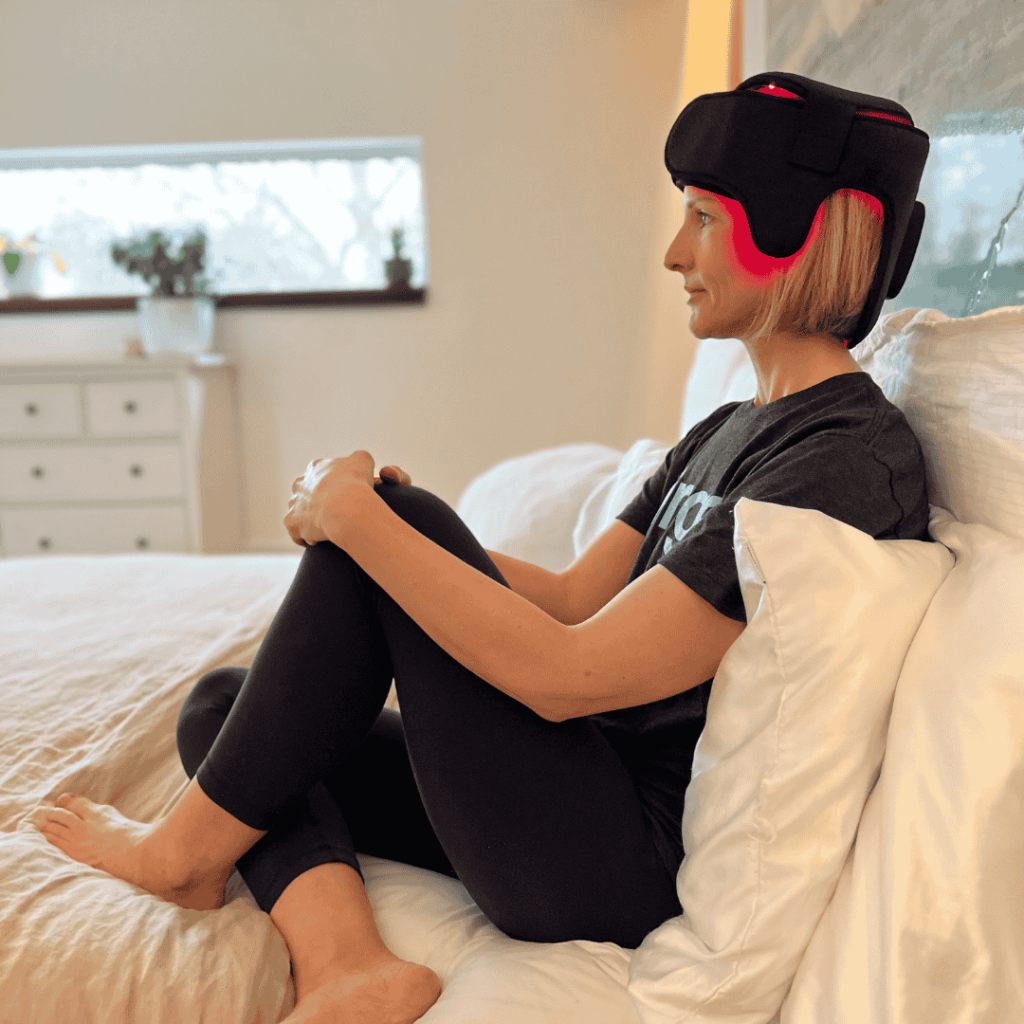
red light therapy wraps
Red Light Therapy Wraps deliver light directly to the skin and can be applied to specific body parts, such as the head and abdomen. They should also deliver both red and near infrared light. Wraps have the advantage of being cordless and very convenient to use. The Fringe Red Light Therapy Head Wrap delivers light to the head (including red and two wavelengths of near infrared light) and is ideally suited to support mood, cognition, and hair loss. The Fringe Red Light Therapy Wrap has a rectangular shape and can be applied to the abdomen to support bladder function and digestion.
light therapy face mask
Like wraps, face masks deliver light directly to the skin but are specifically contoured to the face. Due to the antimicrobial effects of blue light, it should be included in face masks for the treatment of acne along with red and near infrared light. The Fringe Red Light Therapy Face Mask delivers all three wavelengths of light to support skin health, including acne, wrinkles, pigmentation, and more.
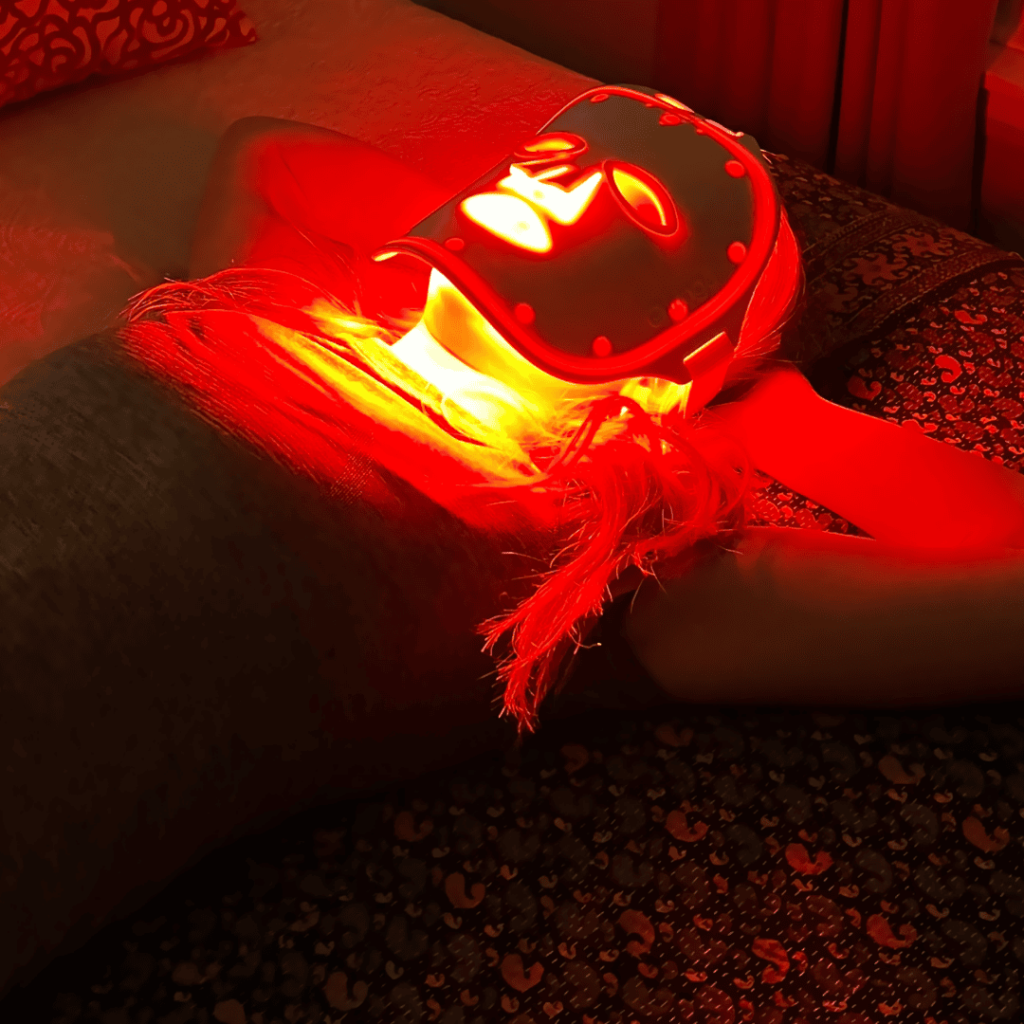
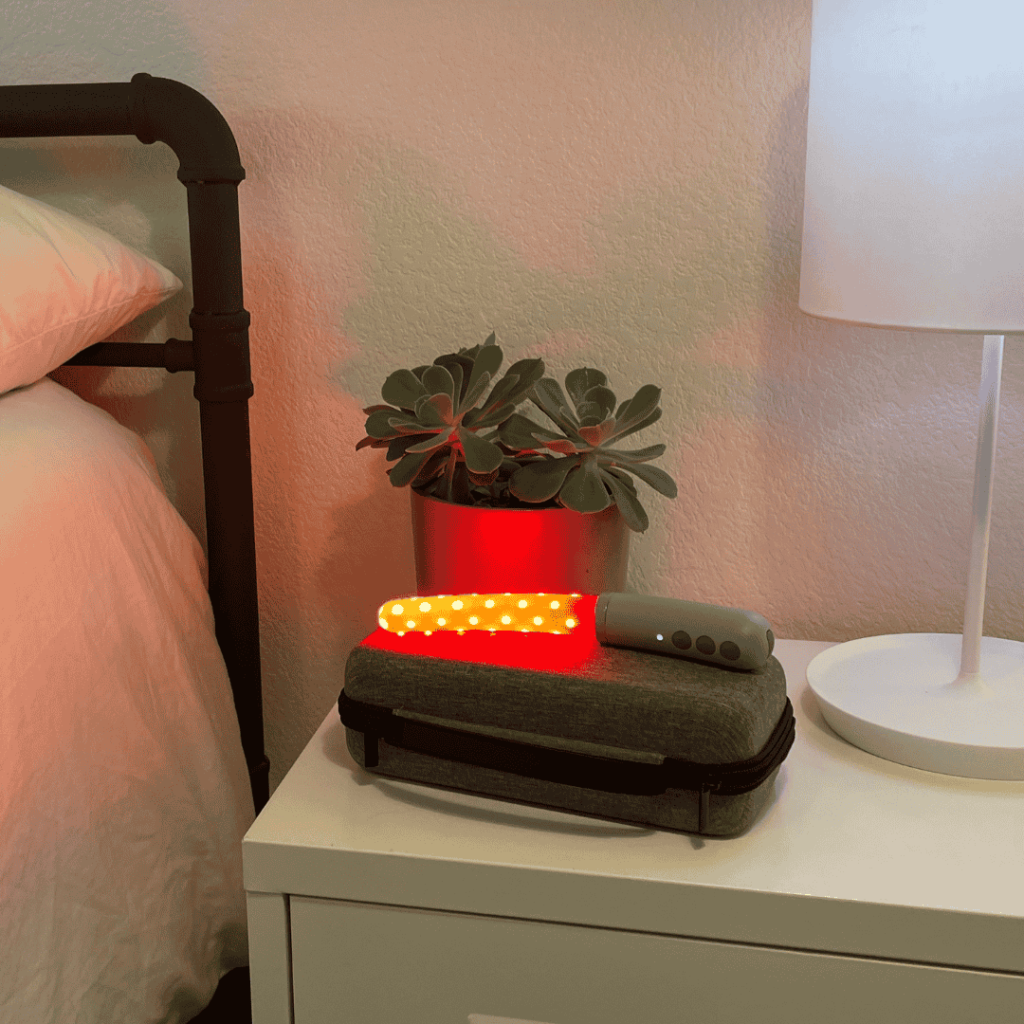
light therapy pelvic wand
Light therapy pelvic wands are inserted directly into the vagina, delivering light directly to the vaginal tissues that are affected by menopausal hormonal changes. The Fringe Light Therapy Wand delivers red, near infrared, and/or blue light to support blood flow and tissue rejuvenation, which may help alleviate vaginal dryness, atrophy, and sexual dysfunction.
to recap
Menopause is a time of dramatic hormonal changes, which create uncomfortable symptoms for many women. Light therapy is a safe and effective tool that may be used to alleviate a wide range of menopausal symptoms in the comfort of one’s own home. Red and near infrared light provide support for symptoms including sleep and mood issues, cognitive changes, hair loss, gut and vaginal dysbiosis, skin problems, and vaginal tissue changes, while blue light may provide antimicrobial activity for menopausal acne and vaginal infections. Many different light therapy products are available – including panels, wraps, face masks, and pelvic wands – that provide light therapy support for different symptoms. Choose products that use LED lights to deliver red, infrared red, and blue light (where appropriate) at approximately the same intensity of the sun for best results.
For more information about Fringe light products, go to: https://fringeheals.com/shop-all-products/
about the author
Dr. Genevieve Newton, DC, PhD spent close to 20 years as a researcher and educator in the field of nutritional sciences before joining Fringe as its Scientific Director. Gen’s job is to “bring the science” that supports Fringe’s products and education. She is passionate about all things Fringe, and is a deep believer in healing body, mind and spirit using the gifts of the natural world.
The contents in this blog; such as text, content, graphics are intended for educational purposes only. The Content is not intended to substitute for professional medical advice, diagnosis, or treatment. Always seek the advice of your healthcare provider.
